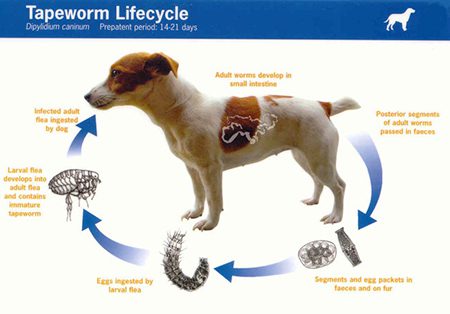
Péisteanna ribíní i madraí: conas iad a aimsiú agus fáil réidh leo
Finding tapeworms in dog feces will not bring joy to any owner. Fortunately, parasites are not as dangerous as you might think, but their appearance is very unpleasant and raises a lot of questions. What are long white worms in a dog and how to get them out?
Clár ábhair
Tapeworms in dogs: what is it?
Tapeworms in dogs are long, flat, white worms that attach themselves to the inner wall of the pet’s small intestine with their hook-shaped mouths called proboscis. They survive on the nutrients that the dog’s body is trying to absorb.
Although dog owners see only tiny segments that are detached from the worm’s body and excreted in the stool (proglottids), a typical tapeworm is over 15 cm long.
Tapeworms in dogs can be transmitted in a variety of ways depending on the species. Dipylidium caninum is the most common type of tapeworm in dogs and is transmitted by fleas.
If a pet swallows the larvae of infected fleas, a tapeworm will begin to mature in its body. This worm will then attach itself to the wall of the small intestine and begin to secrete proglottids. In another case, tapeworms Taenia spp. dogs become infected by eating infected prey, primarily rabbits and other rodents.
An extremely rare species of tapeworm, which is found only in certain regions, is called Echinococcus multilocularis. Infection with this parasite can lead to a painful condition called alveolar echinococcosis. Foxes, cats and small rodents can also become infected with it, but it affects people very rarely.
Tapeworms in dogs: is it dangerous?
Finding tapeworms in dog feces is not the end of the world. In fact, veterinarians classify these parasites as mere nuisances. They do not cause weight loss, vomiting or diarrhea in dogs and do not leave behind any permanent damage.
However, severe D. caninum infections are a sign that the pet has been exposed to a large number of flea larvae. In this case, the dog will constantly feel itchy in response to the slow sucking of his blood by adult fleas. Although nutritional depletion is theoretically possible, it is rarely seen in practice.
Comharthaí péisteanna ribíní i Madraí
The best way to diagnose the presence of this parasite in a dog is to actually find tapeworms, segments of proglottids in its feces. Standard microscopic examination of stool, which is used by specialists to detect other parasites, usually does not work with tapeworm infestations.
These parasites have been reported to occasionally cause itching in dogs, but any scratching on the back of the dog indicates an underlying flea allergy rather than the presence of tapeworms.
The dog became infected with tapeworms: do I need veterinary help
It is recommended that you contact your veterinarian immediately after finding tapeworms, the doctor will examine the pet, if necessary, prescribe tests, and drugs to combat parasites. Tapeworms cannot be removed unless efforts are made to combat all parasites. If the dog becomes infected, the specialist will provide all the necessary information on what to do and how to prevent infections in the future.
Cóireáil péisteanna ribíní i Madraí
Treating tapeworms in dogs is generally fairly straightforward. Most commonly, a dog is given two doses of a drug called praziquantel two weeks apart. The goal of treatment is to interrupt the life cycle of any parasites that the pet has. Two doses are usually sufficient to cure these infections, but recurrences often occur after treatment ends. This is because while tapeworms are easy to get rid of, fleas are much more difficult to get rid of. In addition, protecting the dog from unpleasant tapeworms implies the mandatory treatment and prevention of flea bites.
To prevent tapeworms from entering the digestive tract of a dog, it is necessary not only to destroy fleas, but also to prevent them from entering the environment. New generation flea products are able to destroy fleas and prevent their appearance with almost 100% effectiveness. Regular intake of these drugs is essential to ensure that tapeworm infections are prevented..
Can people get tapeworms from dogs?
Common tapeworms are not transmitted from dogs to humans. However, if you accidentally swallow a flea, there is a chance that the tapeworm will take up residence in the human body. Children are more likely to ingest fleas than adults, so keep a close eye on toddlers who play with your dog.
If the owner or their loved ones become infected with a tapeworm, do not panic. Just like in dogs, tapeworms in humans are highly treatable. You need to call the doctor, and he will prescribe the proper treatment.





